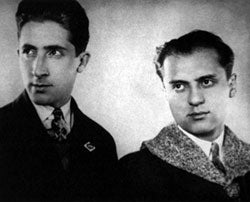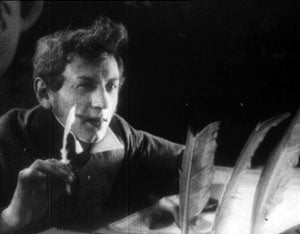This year’s “Days of Silent Film,” held October 1-8 in Pordenone, Italy, was very much a mixed bag, including canonical works, like Leopold Jessner’s Backstairs (1923), Chaplin and Keaton, previously lost Italian silents, programs of early cinema, the Thanhouser Company, Michael Curtiz in Europe, American Westerns from the new NFPF DVD set, Georgian cinema, and assorted restorations and rediscoveries. Due to the opening of our own program, “L.A. Rebellion: Creating a New Black Cinema,” I left early, but did manage to rediscover some of the amazing films of the Soviet FEKS group.

That acronym stood for the “factory of the eccentric actor,” a theater founded in July 1922 in Leningrad by a number of Soviet revolutionary artists, but headed primarily by film directors Gregori Kozintev and Leonid Trauberg, who shared credit on all their productions. Taking their cues from the manifestoes of the constructivists, futurists, dadists, and other early 20th century isms, the FEKS group proclaimed “eccentricism.” Eschewing naturalist and realist aesthetics, FEKS believed in a heady mixture of highly stylized acting, low brow entertainments (like the circus), and dadaist shock and nonsense effects, all infused with Soviet revolutionary politics. Sergei Eisenstein in his Protokult Theatre mined a similar vein in Moscow in the mid-1920s, but the Leningrad group continued to make films until the coming of sound. I had seen one or two of their films on video over the years, but nothing prepared me for the amazing visual power of their work on the big screen. And even if the print quality was often distressed, it was clear that these films were very different from the grey, documentary look of the montage films of Eisenstein, Pudovkin and Dziga Vertov.
The very first scenes of The Devil’s Wheel (1926) already demonstrated their intense interest in “extreme pictorial photography,” as Kozintsev later formulated it. Shot in a Leningrad amusement park at night, as a group of sailors enjoy a few hours of shore leave, the film’s images alternate between the intense movement of people, and the cacophony of light surrounding the “Peoples’ Park.” This surrealist atmosphere continues, as the film introduces us to the city’s criminal underground, where illegal nightclubs feature drug-crazed musicians, frenetic dancing and enough strange characters to fill a circus.

The FEKS adaptation of Gogol’s The Overcoat (1926), likewise eschewed “a parade of historical costumes,” attempting instead through pictorial design to create “a feeling for the epoch.” Indeed, the dehumanzing atmosphere of an entrenched imperial bureaucracy is conveyed in images of heavy, black fur-lined overcoats marching through the brutal Leningrad winter snow at night, and the stasis of a lowly clerk endlessly copying official documents until death overtakes him.
SVD–The Club of the Great Deed (1927) likewise begins with a blinding, nighttime snowstorm as we see a lonely soldier guarding a bridge during the Decembrist Revolution of 1825-'26. Rather than focusing on the historical events of the uprising against Czar Alexander, the filmmakers reduce the story to a struggle between an amoral gambler/conspirator and a romantic young lieutenant who joins the Revolution. Where American cinema would have turned the melodrama into continuous action and movement, here we see tableau, as actors freeze into stylized poses. All but three scenes were shot at night, again allowing cinematographer Andrei Moskvin to create a haunting atmosphere of light and dark, snow-swept exteriors and smoke-filled interiors. One particular scene in a gambling den features an invisible smoker continuously blowing smoke rings into the mise-en-scene produced by future director, Fredrikh Ermler.

Although not a member of the FEKS, Ermler was responsible for a similarly atmospheric film, Fragments of an Empire (1929). The film is a symphony of light and shadow, blinding flurries and locomotive steam, black night skies and beams of light, chaotic movement of bodies and the stasis of corpses in the snow, as the Red Army retreats during the Russian civil war. The utter brutality of war is undergirded by the image of a row of corpses and/or dying soldiers, as a peasant woman commands her mute and amnesiac servant to pull off the boots of the dead.
In a flashback explaining the cause of the soldier’s amnesia, we see a single, thin line of light through the middle of the image (I thought first the projectionist had miscued the frame line) as two opposing soldiers approach each other on a vast field of snow at night. And while the film’s later post-revolutionary sequences feature highly abstracted montages indebted to Eisenstein and Vertov, it is the scenes that lack all movement which remain in memory, for example, when the amnesiac confronts his former boss, a surprisingly sympathetic Jewish factory owner and capitalist.
Finally, it was reseeing the German expressionist Backstairs (1921) after more than 30 years that I realized the stylistic parallels between Weimar art cinema and FEKS, especially in their chiaroscuro lighting and obsession with expressing pure human emotion through physical gesture and stasis, rather than dialogue and action.






 Mobile Navigation
Mobile Navigation

